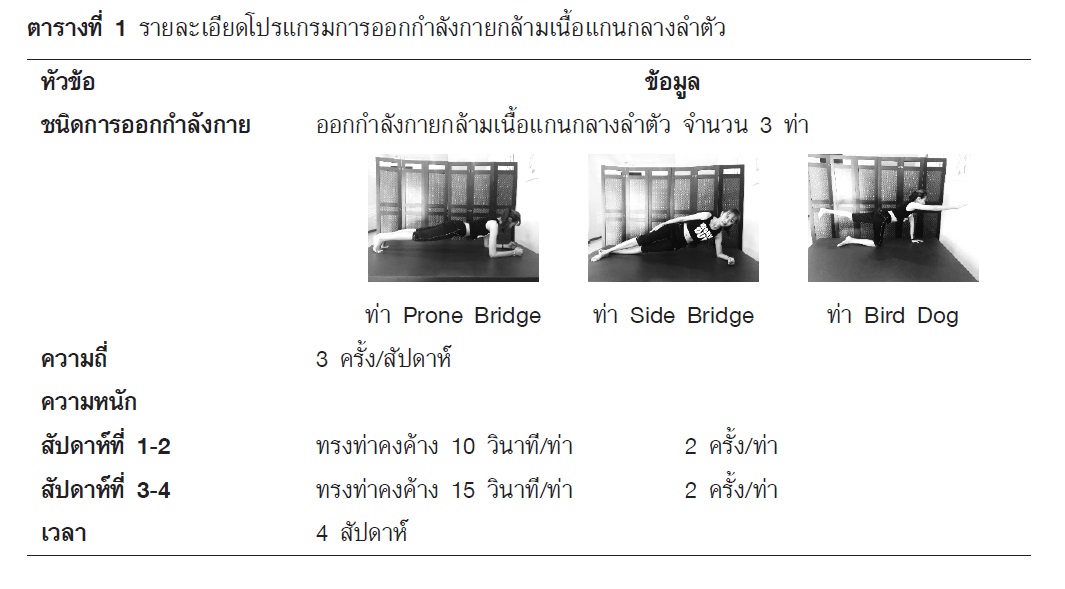ผลของการฝึกกล้ามเนื้อแกนกลางลำตัวที่มีต่อความแข็งแรงและความทนทานของกล้ามเนื้อหน้าท้องและความสามารถในการลุกยืนในวัยรุ่นที่มีภาวะอ้วน : การศึกษานำร่อง
Main Article Content
บทคัดย่อ
วัตถุประสงค์ : การศึกษานี้เป็นการศึกษานำร่อง เพื่อศึกษาผลของการฝึกกล้ามเนื้อแกนกลางลำตัว เป็นเวลา 4 สัปดาห์ ที่มีต่อการพัฒนาสมรรถภาพกล้ามเนื้อในวัยรุ่นเพศชายที่มีภาวะอ้วน
วิธีดำเนินการวิจัย : กลุ่มตัวอย่างเป็นวัยรุ่นเพศชาย อายุระหว่าง 16-18 ปี ที่มีภาวะอ้วน (BMI=30-34 กิโลกรัมต่อตารางเมตร) จำนวน 10 คน กลุ่มออกกำลังกาย (จำนวน 5 คน) และกลุ่มควบคุม (จำนวน 5 คน) กลุ่มออกกำลังกายเข้าร่วมการฝึกกล้ามเนื้อแกนกลาง โดยใช้การฝึก 3 ท่า ประกอบด้วย ท่า prone bridge ท่า side bridge และ ท่า bird dog ท่าละ 2 ครั้ง โดยค้างไว้ท่าละ 10-15 วินาที/ครั้ง ความถี่ 3 ครั้ง/สัปดาห์ เป็นเวลา 4 สัปดาห์ ส่วนกลุ่มควบคุมใช้ชีวิตตามปกติและไม่ได้รับการฝึก ประเมินผลด้วยการทดสอบ ลุกขึ้นยืน และการทดสอบลุกนั่ง ก่อนและหลังการฝึกในสัปดาห์ที่ 4
ผลการวิจัย : หลังฝึกออกกำลังกาย 4 สัปดาห์ ความแข็งแรงและความทนทานของกล้ามเนื้อของอาสาสมัครกลุ่มออกกำลังกายดีขึ้น โดยพบว่า เวลาที่ใช้ในการทดสอบลุกขึ้นยืน 5 ครั้งลดลง รวมถึงจำนวนครั้งในการทดสอบลุกนั่ง 30 วินาทีเพิ่มมากขึ้น อย่างมี นัยสำคัญทางสถิติ เมื่อเปรียบเทียบกับก่อนออกกำลังกายและกลุ่มควบคุม (p<0.05)
สรุปผลการวิจัย : จากผลการศึกษาพบว่า การฝึกกล้ามเนื้อแกนกลางลำตัว สามารถส่งเสริมการพัฒนาสมรรถภาพกล้ามเนื้อที่สัมพันธ์กับการลุก-ยืนในวัยรุ่นที่มีภาวะอ้วนได้
Article Details
References
สถาบันวิจัยระบบสาธารณสุข โดย วิชัย เอกพลากร, ลัดดา เหมาะสุวรรณ, นิชรา เรืองดารกานนท์, วราภรณ์ เสถียรนพเกล้า, หทัยชนก พรรคเจริญ รายงานการสำารวจสุขภาพประชาชนไทยโดยการตรวจร่างกายสุขภาพเด็ก ครั้งที่ 5 พ.ศ. 2557. (online). วันที่ทำการสืบค้น 9 กรกฎาคม 2562, https://www.hiso.or.th/hiso5/report/report2014kid.php
American College of Sports Medicine. (2013). ACSM’s guidelines for exercise testing and prescription. Lippincott Williams & Wilkins.
Chamnongkich S, Wongsaya E & Pratanaphon S. (2013). Trunk displacement during the Sit-to-stand test in young adults. Bulletin of Chiang Mai Associated Medical Sciences, 46(2): 131-140
Cole, T. J., Bellizzi, M. C., Flegal, K. M., & Dietz, W. H. (2000). Establishing a standard definition for child overweight and obesity worldwide: international survey. British Medical Journal, 320(7244), 1240-1243. doi: 10.1136/bmj.320.7244.1240
Csuka, M., & McCarty, D. J. (1985). Simple method for measurement of lower extremity muscle strength. The American Journal of Medicine, 78(1), 77-81. doi: 10.1016/0002-9343(85)90465-6
Dello Iacono, A., Padulo, J., & Ayalon, M. (2016). Core stability training on lower limb balance strength. [Randomized Controlled Trial]. Journal of Sports Science and Technology. 34(7), 671-678. doi: 10.1080/ 02640414.2015.1068437
Ervin, R. B., Fryar, C. D., Wang, C. Y., Miller, I. M., & Ogden, C. L. (2014). Strength and body weight in US children and adolescents. Pediatrics, 134(3), e782-789. doi: 10.1542/peds.2014-0794
Hasan, N. A. K., Kamal H. M. and Hussein Z. A. (2016). Relation between body mass index percentile and muscle strength and endurance. Egyptian Journal of Medical Human Genetics, 17(4): 367-372.
Hibbs, A. E., Thompson, K. G., French, D., Wrigley, A., & Spears, I. (2008). Optimizing performance by improving core stability and core strength. Journal of Sports Medicine, 38(12), 995-1008. doi: 10.2165/ 00007256-200838120-00004
Hulens, Vansant, G., Lysens, R., Claessens, A. L., Muls, E. and Brumagne, S. (2001). Study of differences in peripheral muscle strength of lean versus obese women: an allometric approach. International Journal of Obesity and Related Metabolic Disorders, 25(5): 676-681.
Kibler, W. B., Press, J., & Sciascia, A. (2006). The role of core stability in athletic function. Sports Medicine, 36(3), 189-198. doi: 10.2165/00007256-200636030-00001
Nunez-Gaunaurd, A., Moore, J. G., Roach, K. E., Miller, T. L., & Kirk-Sanchez, N. J. (2013). Motor proficiency, strength, endurance, and physical activity among middle school children who are healthy, overweight, and obese. Pediatric Physical Therapy, 25(2), 130-138; discussion 139. doi: 10.1097/ PEP.0b013e318287caa3
Okada, T., Huxel, K. C., & Nesser, T. W. (2011). Relationship between core stability, functional movement, and performance. [Randomized Controlled Trial]. The Journal of Strength and Conditioning Research, 25(1), 252-261. doi: 10.1519/JSC.0b013e 3181b22b3e.
Prakanta, P. and Pratanaphon, S. (2012). Comparisons in physical fitness between obese, overweight and normal weight children aged 6-12 years old. Journal of Associated Medical Sciences, 45(3): 49-58.
Pongprapai, S., Mo-suwan, L., & Leelasamran, W. (1994). Physical fitness in obese school children in Hat Yai, Southern Thailand. The Southeast Asian Journal of Tropical Medicine and Public Health, 25, 354-354.
Rahmat A., Naser H., Belal M. and Hasan D. (2014). The effect of core stabilization exercises on the physical fitness in children 9-12 years. Sports Science Society of Roman, 10(3): 2401
Samokham, N., & Sitilertpisan, P. (2016). Effect of dynamic core stability exercise on physical performance in male dragon boat paddlers. Journal of Associated Medical Sciences, 49(1), 146-146.
Sasaki, S., Nagano, Y., Kaneko, S., Sakurai, T., & Fukubayashi, T. (2011). The Relationship between Performance and Trunk Movement During Change of Direction. Journal of Sports Science and Medicine, 10(1), 112-118.
Sarah, J., Gribbin, T. C., Lisman, P., Murphy, K., & Deuster, P. A. (2017). Systematic review of the association between physical fitness and musculoskeletal injury risk: Part 2— Muscular endurance and muscular strength. The Journal of Strength & Conditioning Research, 31(11), 3218-3234.
Schilling J. F., Murphy J. C., Bonney J. R., & Thich J. L. Effect of core strength and endurance training on performance in college students: randomized pilot study. Journal of Bodywork and Movement Therapies. 2013 Jul;17(3):278-90. doi: 10. 1016/j.jbmt.2012.08.008. Epub 2012 Sep 15. PMID: 23768270.
Thivel, D., Ring-Dimitriou, S., Weghuber, D., Frelut, M. L., & O’Malley, G. (2016). Muscle Strength and Fitness in Pediatric Obesity: a Systematic Review from the European Childhood Obesity Group. [ReviewSystematic Review]. Obesity Facts, 9(1), 52-63. doi: 10.1159/000443687
Whitney, S. L., Wrisley, D. M., Marchetti, G. F., Gee, M. A., Redfern, M. S., & Furman, J. M. (2005). Clinical measurement of sit-to-stand performance in people with balance disorders: validity of data for the Five-Times-Sit-to-Stand Test. Physical Therapy, 85(10), 1034-1045.
World Health Organization: Childhood overweight and obesity 2014. (Online). Retrieved January 24, 2017, from World Health Organization Website: www.who.int/diet physicalactivity/childhood
Xu, X., Mirka, G. A., & Hsiang, S. M. (2008). The effects of obesity on lifting performance. Applied Ergonomics, 39(1), 93-98. doi: 10.1016/j.apergo.2007.02.001
Zalesin, K. C., Franklin, B. A., Miller, W. M., Peterson, E. D., & McCullough, P. A. (2011). Impact of obesity on cardiovascular disease. [Review]. Medical Clinics of North America, 95(5), 919-937. doi: 10.1016/j.mcna. 2011.06.005

